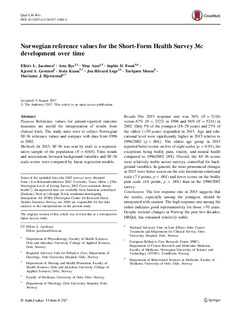| dc.contributor.author | Jacobsen, Ellisiv Lærum | |
| dc.contributor.author | Bye, Asta | |
| dc.contributor.author | Aass, Nina Kathrine | |
| dc.contributor.author | Fosså, Sophie Dorothea | |
| dc.contributor.author | Grotmol, Kjersti Støen | |
| dc.contributor.author | Kaasa, Stein | |
| dc.contributor.author | Loge, Jon Håvard | |
| dc.contributor.author | Moum, Torbjørn Åge | |
| dc.contributor.author | Hjermstad, Marianne Jensen | |
| dc.date.accessioned | 2018-01-29T11:45:26Z | |
| dc.date.available | 2018-01-29T11:45:26Z | |
| dc.date.created | 2017-10-30T15:15:59Z | |
| dc.date.issued | 2017 | |
| dc.identifier.citation | Quality of Life Research. 2017, 1-12. | nb_NO |
| dc.identifier.issn | 0962-9343 | |
| dc.identifier.uri | http://hdl.handle.net/11250/2480245 | |
| dc.description.abstract | Purpose
Reference values for patient-reported outcome measures are useful for interpretation of results from clinical trials. The study aims were to collect Norwegian SF-36 reference values and compare with data from 1996 to 2002.
Methods
In 2015, SF-36 was sent by mail to a representative sample of the population (N = 6165). Time trends and associations between background variables and SF-36 scale scores were compared by linear regression models.
Results
The 2015 response rate was 36% (N = 2118) versus 67% (N = 2323) in 1996 and 56% (N = 5241) in 2002. Only 5% of the youngest (18–29 years) and 27% of the oldest (>70 years) responded in 2015. Age and educational level were significantly higher in 2015 relative to 1996/2002 (p < .001). The oldest age group in 2015 reported better scores on five of eight scales (p < 0.01), the exceptions being bodily pain, vitality, and mental health compared to 1996/2002 (NS). Overall, the SF-36 scores were relatively stable across surveys, controlled for background variables. In general, the most pronounced changes in 2015 were better scores on the role limitations emotional scale (7.4 points, p < .001) and lower scores on the bodily pain scale (4.6 points, p < .001) than in the 1996/2002 survey.
Conclusions
The low response rate in 2015 suggests that the results, especially among the youngest, should be interpreted with caution. The high response rate among the oldest indicates good representativity for those >70 years. Despite societal changes in Norway the past two decades, HRQoL has remained relatively stable. | nb_NO |
| dc.language.iso | eng | nb_NO |
| dc.publisher | Springer Verlag | nb_NO |
| dc.rights | Navngivelse 4.0 Internasjonal | * |
| dc.rights.uri | http://creativecommons.org/licenses/by/4.0/deed.no | * |
| dc.title | Norwegian reference values for the Short-Form Health Survey 36: development over time | nb_NO |
| dc.type | Journal article | nb_NO |
| dc.type | Peer reviewed | nb_NO |
| dc.description.version | publishedVersion | nb_NO |
| dc.source.pagenumber | 1-12 | nb_NO |
| dc.source.journal | Quality of Life Research | nb_NO |
| dc.identifier.doi | 10.1007/s11136-017-1684-4 | |
| dc.identifier.cristin | 1509010 | |
| dc.description.localcode | © The Author(s) 2017 This article is distributed under the terms of the Creative Commons Attribution 4.0 International License (http://creativecommons.org/licenses/by/4.0/) | nb_NO |
| cristin.unitcode | 194,65,15,0 | |
| cristin.unitname | Institutt for klinisk og molekylær medisin | |
| cristin.ispublished | true | |
| cristin.fulltext | preprint | |
| cristin.qualitycode | 2 | |

